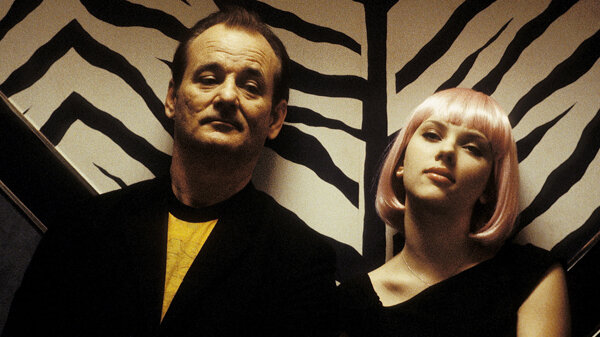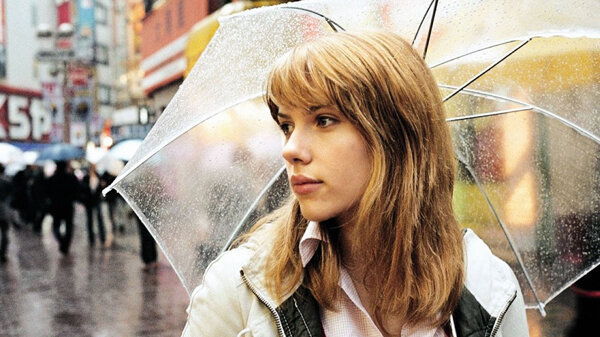Sofia Coppola’s 2003 film might offer a strong understanding of the midlife crisis, but there’s also much to be said of its depiction of quarter-life ambiguity and inertia. Plus, in the midst of a global lockdown – it offers a reminder that ennui isn’t necessarily evil. Aobh O’Brien-Moody investigates.
“I just don’t know what I’m supposed to be.” It’s an intimate confession from one lost soul in the throes of an identity crisis to another, as the two lie side by side on a plush hotel bed high above the swarming streets of Tokyo. She: twenty-something philosophy graduate Charlotte (played so thoughtfully by a fresh-faced Scarlett Johansson) and he, Bob Harris (Bill Murray), an ageing actor who fears he’s past his prime. Despite the almost three-decade age gap, both are adrift, struggling to navigate their lives purposefully and unable to relate to the world around them. Strangers in a foreign city, they form an unlikely friendship, connecting over their shared sense of disconnection. Whilst Bob is attempting to extricate himself from the images that have come to define him throughout his past, Charlotte is seeking some sort of meaning to attach her future to.
I was 16 when I first watched Sofia Coppola’s 2003 film Lost in Translation. I was instantly enthralled and, like every other Tumblr-obsessed, analogue camera-wielding teenage girl at the time, I quickly declared it my favourite film. But it was only recently, upon an umpteenth re-watch, that Charlotte’s words resonated so deeply. At 24 years of age, I find myself relating to her sense of disquietude and uncertainty all too well. Trapped in an awkward state of limbo, I – like so many of my millennial peers – am experiencing existential anguish and self-doubt as I grapple with figuring out what I want for myself, or “what I’m supposed to be”. We’ve been fed the clichés of a midlife crisis (“Did you buy a Porsche yet?” Charlotte teases Bob), but the lesser-recognised quarter-life crisis is a different beast. It’s driven by anxieties about the future and ever-mounting, seemingly urgent pressures to have it all together personally and professionally. The conflict between expectation – fulfilling career, stable relationship, financial security – and reality – nope, nope and nope – results in torturous disappointment and a crushing sense of unfulfillment. Add to this the overwhelming uncertainties associated with the pandemic we’re currently living through – it’s enough to make me want to take a very long lie down.
Coppola’s delicate treatment of Charlotte’s plight stems from her own unique identity crisis in her twenties. “I got married not long before and kind of felt isolated,” the filmmaker told Little White Lies. “I was in this stage where I wasn’t sure if I’d made the right choices or what I was doing in the post-college beginning of my adult life… I was looking a lot at the idea of being connected because at that moment, I wasn’t.” Her first-hand insight and empathetic understanding manifests in a poignantly understated portrait of malaise. Charlotte, stuck in a dissatisfying marriage to a careerist photographer, is left to her own devices in Tokyo as her husband gallivants around the country photographing celebrities. She spends much of her time alone in their hotel room doing nothing in particular – pottering about in a state of partial undress; listening, somewhat bemusedly, to a self-help CD entitled A Soul’s Search; staring pensively out the window at the bustling city below her. These scenes of nothingness are an intimate glimpse into her private state of being, offering a sense of her painful listlessness. At one point, Charlotte looks at her reflection in the mirror, applying lipstick and playing with her hair. She experiments with versions of her image, toying with variations of her identity as she ponders which one she most wants to adopt, which one best reflects who she is supposed to be.
Central to the film is the theme of disconnection. Unsure of her place in the world, Charlotte moves through public spaces with hesitancy. Her internal sense of detachment is reinforced by her foreign surroundings – unfamiliar streets; a bustling train station; a Buddhist temple. So much is going on around her, yet she fails to relate. Back in the hotel room, she calls a friend in tears. “There were these monks and they were chanting and I didn’t feel anything,” she laments, as she stares out the windows. This all-consuming pressure to feel; to be; to do; to know, is a symptom of contemporary Western life and a root cause of the quarter-life crisis – even more so today, almost 20 years since Lost in Translation’s release, thanks to the demanding expectations and the culture of comparison that social media breeds. Not to mention the overwhelming pressure to self-optimise (Bake sourdough! Write a novel! Learn three new languages!) that we’re being confronted with in the midst of the coronavirus lockdown. Society condemns ambiguity and inertia of any kind, as they are not conducive to our limited understanding of what it means to be successful, which ultimately is exclusively seen as being productive.
Coppola beautifully honours these notions of ambiguity and inertia. She worked with producer Brian Reitzell to curate a Tokyo dream-pop soundtrack, composed of music she listened to as she was writing the film. Dreamy, atmospheric tracks by the likes of Air, Phoenix, My Bloody Valentine and The Jesus and Mary Chain lend the scenes a sense of other-worldliness – a feeling heightened by the hazy, ethereal quality of Lance Accord’s sublime cinematography. The use of soft natural lighting and an understated colour palette of predominantly muted cool tones evokes a sense of loneliness and melancholy, imbuing each scene with tender fragility.
For all the unease and discomfort that Lost in Translation toys with, I can’t help but return to it as a source of solace. By traditional narrative standards, little actually happens – there’s no dramatic plot twist, edge-of-seat action or passionate love affair. The film instead deals with quiet, everyday uncertainties and ordinary moments of existence, concepts that feel particularly pertinent in the current unsteady state of the world. Ironically, the reassurance that I feel stems from the absence of resolution. The seminal final scene, in which Bob whispers something inaudible to Charlotte, offers no answers about the fate of our protagonists. It is not revealed whether Charlotte “figures it all out”, or if Bob escapes midlife unscathed. We are instead forced to relax into the possibility of ambivalence and accept that identity need not be a fixed condition or a final destination. It’s the antithesis of the messages that I’ve been fed for so long by an always-on, hustle-obsessed culture. But it’s a refreshing reminder that I – that we – might actually still make it out alive.
Aobh O’Brien-Moody (IG: @aobhobrienmoody) is a London-based journalist who writes about all things lifestyle, culture and fashion related.



